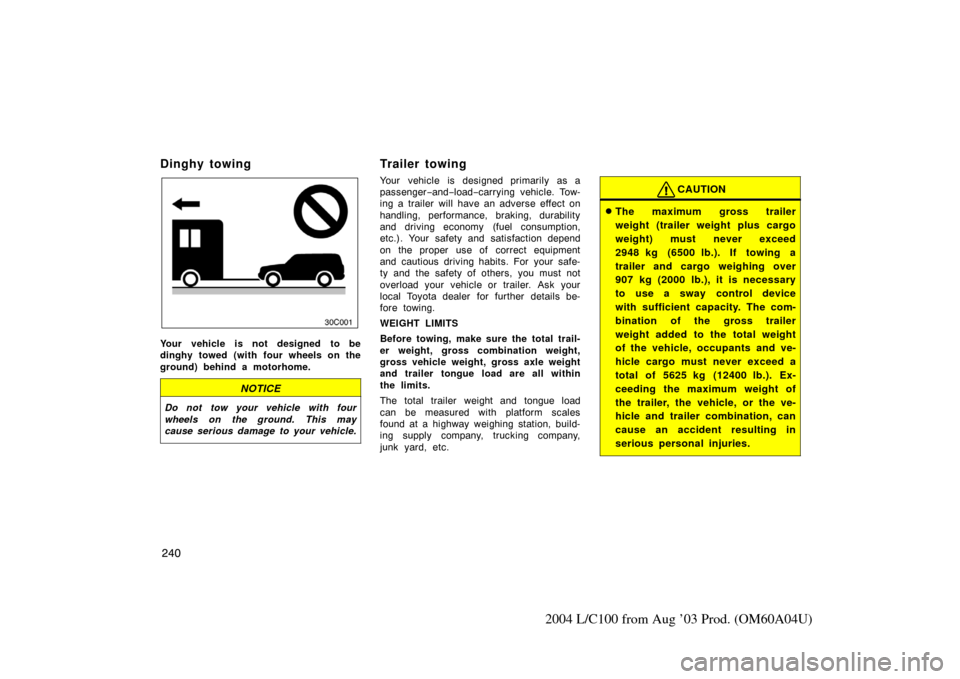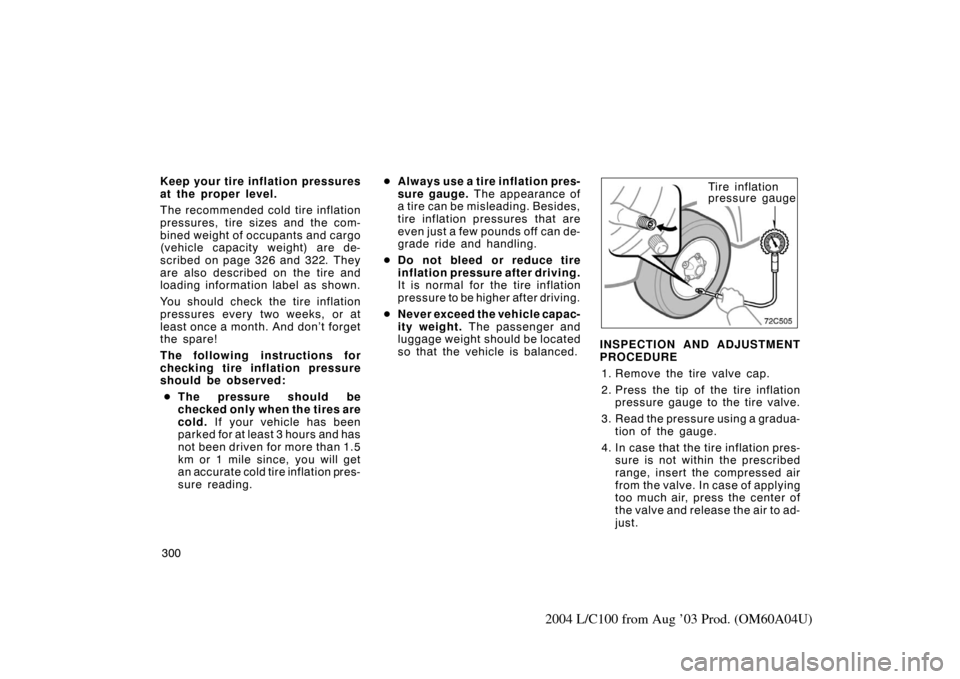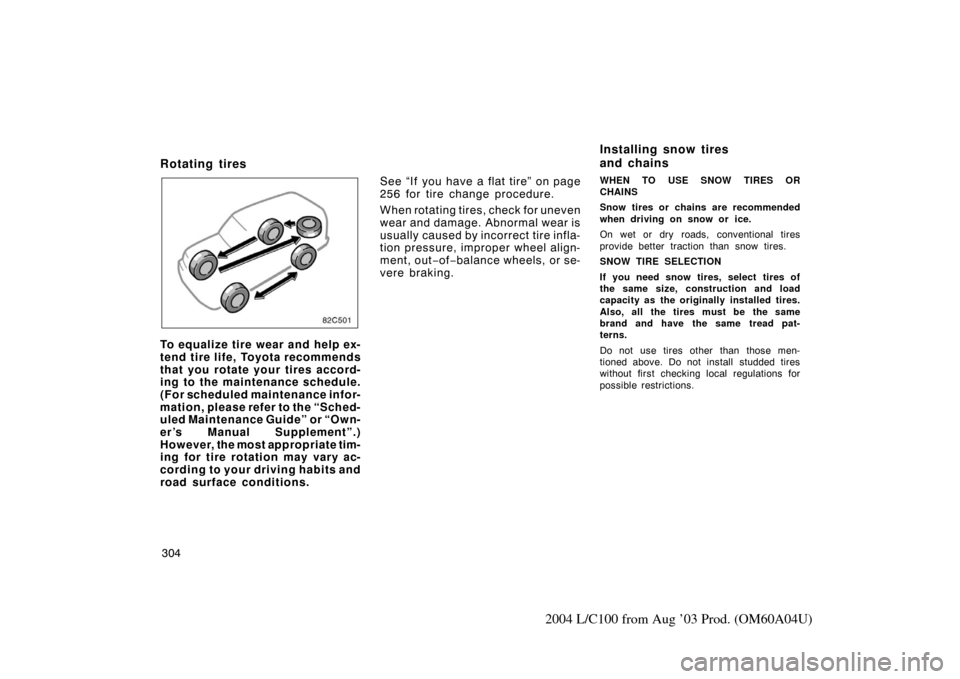Page 248 of 342

240
2004 L/C100 from Aug ’03 Prod. (OM60A04U)
Dinghy towing
30c001a
Your vehicle is not designed to be
dinghy towed (with four wheels on the
ground) behind a motorhome.
NOTICE
Do not tow your vehicle with four
wheels on the ground. This may
cause serious damage to your vehicle.
Trailer towing
Your vehicle is designed primarily as a
passenger−and− load− carrying vehicle. Tow-
ing a trailer will have an adverse effect on
handling, performance, braking, durability
and driving economy (fuel consumption,
etc.). Your safety and satisfaction depend
on the proper use of correct equipment
and cautious driving habits. For your safe-
ty and the safety of others, you must not
overload your vehicle or trailer. Ask your
local Toyota dealer for further details be-
fore towing.
WEIGHT LIMITS
Before towing, make sure the total trail-
er weight, gross combination weight,
gross vehicle weight, gross axle weight
and trailer tongue load are all within
the limits.
The total trailer weight and tongue load
can be measured with platform scales
found at a highway weighing station, build-
ing supply company, trucking company,
junk yard, etc.CAUTION
�The maximum gross trailer
weight (trailer weight plus cargo
weight) must never exceed
2948 kg (6500 lb.). If towing a
trailer and cargo weighing over
907 kg (2000 lb.), it is necessary
to use a sway control device
with sufficient capacity. The com-
bination of the gross trailer
weight added to the total weight
of the vehicle, occupants and ve-
hicle cargo must never exceed a
total of 5625 kg (12400 lb.). Ex-
ceeding the maximum weight of
the trailer, the vehicle, or the ve-
hicle and trailer combination, can
cause an accident resulting in
serious personal injuries.
Page 308 of 342

300
2004 L/C100 from Aug ’03 Prod. (OM60A04U)
Keep your tire inflation pressures
at the proper level.
The recommended cold tire inflation
pressures, tire sizes and the com-
bined weight of occupants and cargo
(vehicle capacity weight) are de-
scribed on page 326 and 322. They
are also described on the tire and
loading information label as shown.
You should check the tire inflation
pressures every two weeks, or at
least once a month. And don’t forget
the spare!
The following instructions for
checking tire inflation pressure
should be observed:
� The pressure s hould be
checked only when the tires are
cold. If your vehicle has been
parked for at least 3 hours and has
not been driven for more than 1.5
km or 1 mile since, you will get
an accurate cold tire inflation pres-
sure reading. �
Always use a tire inflation pres-
sure gauge. The appearance of
a tire can be misleading. Besides,
tire inflation pressures that are
even just a few pounds off can de-
grade ride and handling.
� Do not bleed or reduce tire
inflation pressure after driving.
It is normal for the tire inflation
pressure to be higher after driving.
� Never exceed the vehicle capac-
ity weight. The passenger and
luggage weight should be located
so that the vehicle is balanced.Ti r e inf lat ion
pressure gauge
INSPECTION AND ADJUSTMENT
PROCEDURE 1. Remove the tire valve cap.
2. Press the tip of the tire inflation pressure gauge to the tire valve.
3. Read the pressure using a gradua- tion of the gauge.
4. In case that the tire inflation pres- sure is not within the prescribed
range, insert the compressed air
from the valve. In case of applying
too much air, press the center of
the valve and release the air to ad-
just.
Page 312 of 342

304
2004 L/C100 from Aug ’03 Prod. (OM60A04U)
Rotating tires
To equalize tire wear and help ex-
tend tire life, Toyota recommends
that you rotate your tires accord-
ing to the maintenance schedule.
(For scheduled maintenance infor-
mation, please refer to the “Sched-
uled Maintenance Guide” or “Own-
er’s Manual Supplement”.)
However, the most appropriate tim-
ing for tire rotation may vary ac-
cording to your driving habits and
road surface conditions.See “If you have a flat tire” on page
256 for tire change procedure.
When rotating tires, check for uneven
wear and damage. Abnormal wear is
usually caused by incorrect tire infla-
tion pressure, improper wheel align-
ment, out
−of −balance wheels, or se-
vere braking.
WHEN TO USE SNOW TIRES OR
CHAINS
Snow tires or chains are recommended
when driving on snow or ice.
On wet or dry roads, conventional tires
provide better traction than snow tires.
SNOW TIRE SELECTION
If you need snow tires, select tires of
the same size, construction and load
capacity as the originally installed tires.
Also, all the tires must be the same
brand and have the same tread pat-
terns.
Do not use tires other than those men-
tioned above. Do not install studded tires
without first checking local regulations for
possible restrictions.
Installing snow tires
and chains